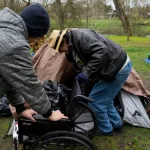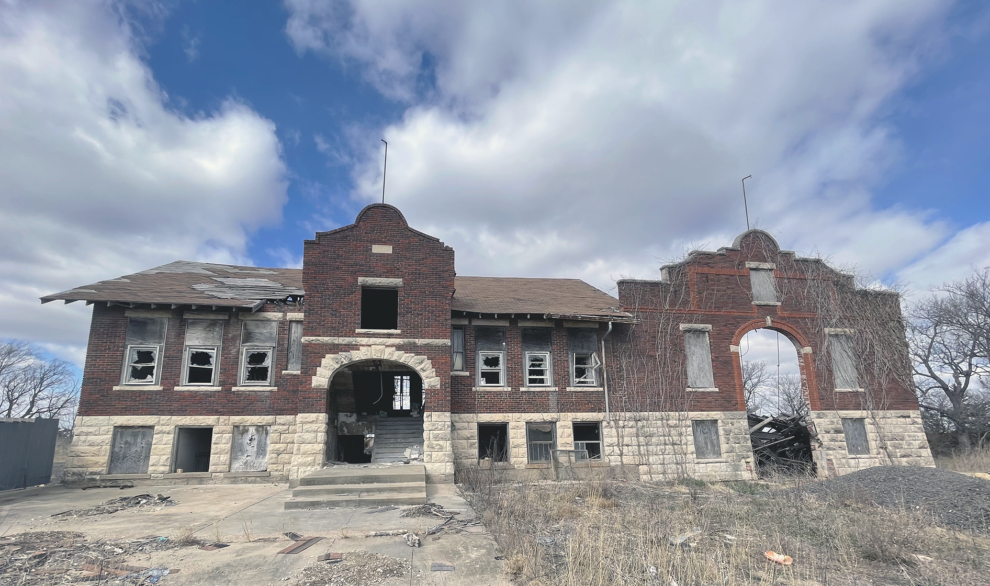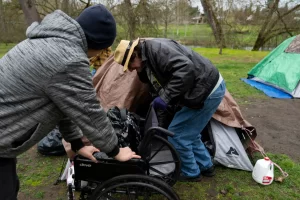Anyone wishing to understand the challenges facing Kansas and its sister plains states should spend time in an abandoned schoolyard.
Study the boarded-up structures; touch the rusty slipper-slide; nudge the squeaky merry-go-round. An instinctive feel will emerge for the dreams of communities past, and with it, a sense of how depopulation and school consolidation have accompanied Kansans on their walks through history.
Kansas Reflector has reported on the vote by Barton County residents to dissolve their school district, as some residents of Wilson react in protest to the proposed closing of their high school. In the early 1900s, Kansas had more than 8,000 organized districts, most of them serving one-room schools. During the 1940s baby boom, the number of Kansas children aged 13 and younger shot up almost 80 percent. Facing population pressure, administrators argued that larger and fewer districts produced lower costs of scale, allowing the fixed expenses of maintaining schools to be spread across more students.
The state legislature responded in 1945 by adopting statewide educational standards. This had far-reaching consequences for both rural and urban areas.
In Topeka, plaintiffs in the Brown v. Board of Education case argued that segregation caused Black schools to fall short of the equality standard set by the state government, opening the door to a successful U.S. Supreme Court ruling, and arguably, the next phase of a civil rights movement. In farm country, educators claimed that rural schools suffered from poorly trained teachers, bad attendance, and lack of extracurricular activities like music and sports, which prepared children socially for modern life.
By 1950, when a whopping one-fourth of all Kansans were of school age, the number of school districts had been reduced to half of what they had been a generation earlier. One- and two-room rural schools were phased out, replaced by town schools answerable more to distant bureaucracies than locally elected officials.
Consolidation was only getting started. Over the next several decades, as small-town businesses shut their doors and the farm crisis continued unabated, the Great Plains saw further rounds of closings. In 1932, the average size for an elementary school in the region was 89. In 2000, it was 446.
– Jim Leiker
Yet consolidation was only getting started. Over the next several decades, as small-town businesses shut their doors and the farm crisis continued unabated, the Great Plains saw further rounds of closings. In 1932, the average size for an elementary school in the region was 89. In 2000, it was 446.
Certainly, some parents welcomed the changes as their children learned and competed in larger arenas, with more opportunities to know kids unlike themselves. Others suffered long transportation distances, higher taxes for ever-increasing programs, and especially when a school closed, the economic and existential consequences for already struggling communities.
The purpose of schools is to educate, but what does “educate” mean? The answer is open to multiple subjective interpretations. The one upon which administrators rely, probably because it is measurable through quantitative data, is test performance. The jargon of assessment, competencies and learning outcomes permeates the way schools and teachers are evaluated now.
All this misses the social context in which education has historically been handled. When people say, “it takes a village,” they could just as well say that learning requires a network of friends, neighbors and mentors — some of whom are qualified to teach subject matter, others not — but all of them invested in that child’s future.
Even in this fast-paced mobile age, that means being rooted in a physical place.
Extremism in the pursuit of provincial control definitely has its dark side. Witness the recent wave of book bans and other exclusionary measures meant to enforce “community values.” Still, consolidation carries costs: the stress upon the rural or city child when their school is replaced by a new facility in a larger town or suburb; the lack of parental involvement when kids are educated too far away, in other people’s neighborhoods; the plummeting property values when a school vanishes in an area with few other social outlets.
Higher education also has felt this sting, as colleges and universities scramble toward online classes as a panacea for boosting enrollment. Sailing through the curriculum from the privacy of home is a practical route to graduation, sure, but without the relationships formed with classmates and professors via in-person interactions, what kind of learning has occurred?
Ultimately, we face a question of balance: how to prepare children to manage on a diverse, complex, and globalizing planet while still acknowledging the reality that education — like politics, like life — is local and personal.
That may be best pondered in one of our many weed-filled schoolyards, where imaginative visitors might hear echoes of gleeful laughter, long since replaced by eerie stillness.
Jim Leiker is professor of history at Johnson County Community College in Overland Park. Through its opinion section, the Kansas Reflector works to amplify the voices of people who are affected by public policies or excluded from public debate. Find information, including how to submit your own commentary, here.
Source : Kansas Reflector






































